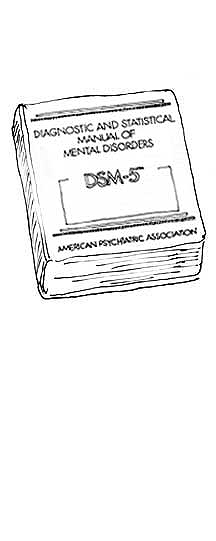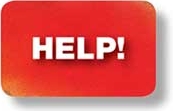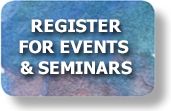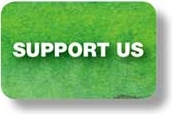
GLOSSARY OF MENTAL DISORDERS, as per DSM-5, in alphabetical order.1
Organized by Julie Ridge, LCSW-R.
Anxiety Disorders (and Phobias).
Attention-Deficit/Hyperactivity Disorder (ADHD).
Bipolar and Related Disorders.
Disruptive, Impulse-Control and Conduct Disorders.
Obsessive Compulsive Disorder (OCD).
Schizophrenia Spectrum and Other Psychotic Disorders.
Substance Use and Addictive Disorders.
Trauma and Stressor Related Disorders
Anxiety Disorders (and Phobias). Anxiety disorders are the most common mental illness in the U.S., affecting more than 40 million adults age 18 and older (18%). Considered the most prevalent disorder of children and adolescents, an estimated 1 in 8 (more than 12%) suffer. 2 Anxiety is sometimes the first warning sign of substance use or other mental disorders. Anxiety disorders include: separation anxiety, agoraphobia, specific phobias, social anxiety disorder, generalized anxiety disorder and panic disorders.
Everyone feels fear and anxiety from time to time. But, if you have an anxiety disorder or phobia, you feel these emotions frequently. Anxiety disorders and phobias differ from developmentally normative fears or anxieties in the following ways:
- They are excessive or persistent beyond developmentally
appropriate ages. - They are out of proportion to the potential threat or danger
(as assessed by a mental health professional). - They typically last 6 months or longer (duration may be shorter in children).
- They typically interfere with day-to-day function academically, socially, behaviorally and/or vocationally.
- The symptoms cannot be attributed to the physiological effects of a substance/medication or to another medical condition, or are not better explained by another mental disorder. 3
[note: In DSM-5, Posttraumatic stress disorder (PTSD) is now classified under trauma and stressor related disorders. Obsessive compulsive disorder (OCD) is a new category.]
Attention-Deficit/Hyperactivity Disorder (ADHD). ADHD is considered one of the most common childhood neurodevelopmental disorders. According to the Centers for Disease Control and Prevention (CDC), approximately 11% of American children between the ages of 4-17 (6.4 million) have been diagnosed with ADHD; boys are nearly three times more likely than girls to have been diagnosed; and the average age of diagnosis is age 7.
Criteria as specified in DSM-5: ADHD consists of a pattern of behavior that persists over six months and is present in multiple settings, where it gives rise to social, educational or work performance difficulties. Either (A1) and/or (A2) must be met:
A. A persistent pattern of inattention and/or hyperactivity-impulsivity that interferes with functioning or development, as characterized by (1) and/or (2):
1. Inattention: Six (or more) of the following symptoms have persisted for at least 6 months to a degree that is inconsistent with developmental level and that negatively impacts directly on social and academic/occupational activities:
Note: The symptoms are not solely a manifestation of oppositional behavior, defiance, hostility, or failure to understand tasks or instructions. For older adolescents and adults (age 17 and older), at least five symptoms are required.
a. Often fails to give close attention to details or makes careless mistakes in schoolwork, at work, or during other activities (e.g. overlooks or misses details, work is inaccurate).
b. Often has difficulty sustaining attention in tasks or play activities
(e.g. has difficulty remaining focused during lectures, conversations, or
lengthy reading).
c. Often does not seem to listen when spoken to directly (e.g. mind seems elsewhere, even in the absence of any obvious distraction).
d. Often does not follow through on instructions and fails to finish schoolwork, chores, or duties in the workplace (e.g. starts tasks but quickly loses focus and is easily sidetracked).
e. Often has difficulty organizing tasks and activities (e.g. difficulty managing sequential tasks; difficulty keeping materials and belongings in order; messy, disorganized work; has poor time management; fails to meet deadlines).
f. Often avoids, dislikes, or is reluctant to engage in tasks that require sustained mental effort (e.g. schoolwork or homework; for older adolescents and adults, preparing reports, completing forms, reviewing lengthy papers).
g. Often loses things necessary for tasks or activities (e.g. school materials, pencils, books, tools, wallets, keys, paperwork, eyeglasses, mobile telephones).
h. Is often easily distracted by extraneous stimuli (for older adolescents and adults, may include unrelated thoughts)
i. Is often forgetful in daily activities (e.g. doing chores, running errands; for older adolescents and adults, returning calls, paying bills, keeping appointments).
2. Hyperactivity and impulsivity: Six (or more) of the following symptoms have persisted for at least 6 months to a degree that is inconsistent with developmental level and that negatively impacts directly on social and academic/occupational activities.
Note: The symptoms are not solely a manifestation of oppositional behavior, defiance, hostility, or a failure to understand tasks or instructions. For older adolescents and adults (age 17 and older), at least five symptoms are required.
a. Often fidgets with or taps hands or feet or squirms in seat.
b. Often leaves seat in situations when remaining seated is expected (e.g. leaves his or her place in the classroom, in the office or other workplace, or in other situations that require remaining in place).
c. Often runs about or climbs in situations where it is inappropriate.
(Note: in adolescents or adults, may be limited to feeling restless.)
d. Often unable to play or engage in leisure activities quietly.
e. Is often “on the go,” acting as if “driven by a motor” (e.g. is unable to be or uncomfortable being still for extended time, as in restaurants, meetings: may be experienced by others as being restless or difficult to keep up with).
f. Often talks excessively.
g. Often blurts out an answer before a question has been completed (e.g. completes people’s sentences; cannot wait for turn in conversation).
h. Often has difficulty waiting his or her turn (e.g. while waiting in line).
i. Often interrupts or intrudes on others (e.g. butts into conversations, games, or activities, may start using other people’s things without asking or receiving permission; for adolescents and adults, may intrude into or take over what others are doing).
B. Several inattentive or hyperactive-impulsive symptoms were present prior to age 12.
C. Several inattentive or hyperactive-impulsive symptoms are present in two or more settings (e.g. at home, school, or work: with friends or relatives; in other activities).
D. There is clear evidence that the symptoms interfere with, or reduce the quality of, social, academic, or occupational functioning.
E. The symptoms do not occur exclusively during the course of schizophrenia or another psychotic disorder and are not better explained by another mental disorder (e.g. mood disorder, anxiety disorder, dissociative disorder, personality disorder, substance intoxication or withdrawal).
Specify whether:
314.01 Combined presentation: If both Criterion A1 (inattention) and Criterion A2 (hyperactivity-impulsivity) are met for the past 6 months.
314.00 Predominantly inattentive presentation: If Criterion A1
(inattention) is met but Criterion A2 (hyperactivity-impulsivity) is not met for
the past 6 months.
314.01 Predominantly hyperactive/impulsive presentation: If Criterion A2 (hyperactivity-impulsivity) is met and Criterion A1 (inattention) is not met for the past 6 months.
Autism Spectrum Disorder. According to the latest statistics from the CDC one in 68 children in the United States are born with autism. A child with autism processes information (e.g. seeing, feeling and sensing) differently than a child without autism. Diagnostically, these differences include:
A. Persistent deficits in social communication and social interaction across multiple contexts, as manifested by challenges in recognizing or understanding facial expressions, social cues, and verbal intonations.
B. Restricted, repetitive patterns of behavior, interests, or activities, as manifested by at least two of the following, currently or by history: repetitive motor movements, use of objects or speech (e.g. lining up toys or flipping objects, echolalia, idiosyncratic phrases); insistence on sameness, inflexible adherence to routines, or ritualized patterns of verbal or non-verbal behavior; highly restricted, fixated interests that are abnormal in intensity or focus (e.g. strong attachment to or preoccupation with unusual objects like vacuum cleaners, subway maps, legos, dinosaurs).
Symptoms must be present in early developmental period (but may not become fully manifest until social demands exceed limited capacities, or may be masked by learned strategies in later life). The earliest symptoms typically show up between the ages of 18 and 24 months.
[note: In DSM-5, pervasive developmental delays (PDD-NOS), autism and Aspergers syndrome are all subsumed under the heading of autism spectrum disorders.]
Bipolar and Related Disorders. “Bipolar disorder (also known as manic-depressive illness) is characterized by extremes in mood and related changes in behavior, thoughts and energy. In this condition, an individual experiences both highs (mania or its milder form, hypomania) and lows (depression), or a mixture of symptoms at the same time. What is tricky about manic symptoms is that unlike depression, they may not be recognized by individuals with the condition, and in fact the symptoms may be enjoyable to them.” 4
“While the most outwardly apparent symptoms are behavioral, the illness often has less visible, but serious, cognitive, cardiac, and metabolic effects. Symptoms may emerge gradually or suddenly during childhood, adolescence, or adulthood. Researchers have identified cases of bipolar disorder in every age group studied, including preschoolers.”5 The symptoms of bipolar disorder come and go, but the condition itself is chronic and requires ongoing management, like diabetes. With good treatment and self-management skills, individuals with bipolar disorder can lead extremely productive and fulfilling lives.
Lifetime prevalence of bipolar disorder in the general population is estimated at about 1%. Life stressors tend to play a part in setting off depressive and/or manic episodes. Some illicit substances (e.g. marijuana, hallucinogens, methamphetamine, stimulants, cocaine, heroine) can trigger a dormant condition or exacerbate an existing one.
Depressive Disorders. “Major depression is a medical condition distinguished by one or more major depressive episodes. An episode is characterized by at least 2 weeks of depressed mood or loss of interest (or pleasure) and accompanied by at least 4 of more symptoms which can include: changes in appetite and/or weight, difficulty thinking and concentrating, or recurrent thoughts of death or suicide. It is different from feeling ‘blue’ or sad in that it causes severe enough problems to interfere with a person’s day-to-day functioning.” 6
The “12-month prevalence of major depressive disorder in the United States is approximately 7%, with marked differences by age group such that the occurrence in 18-29 year olds is 3-fold higher than in individuals age 60 years and older. Females experience 1.5 to 3-fold higher rates than males beginning in early adolescence.” 7 Data shows that 50-75% of children with depression go undiagnosed and untreated.
Disruptive, Impulse-Control and Conduct Disorders. Disruptive behaviors are the second most common mental disorders facing youth today. These disorders are typified by callous disregard for authority and directives, are willful, at times destructive and are usually triggered by serious life stressors.
Statistical measures of the number of children and adolescents with these disorders vary widely. According to the US Department of Health and Human Services Substance Abuse and Mental Health Services Administration (SAMHSA) somewhere between 2 to 16% of youth have oppositional defiant disorder (ODD). The prevalence of conduct disorder (CD) is 6 to 9% and is more commonly diagnosed in boys. 8 Prevalence seems to be fairly consistent across various countries that differ in race and ethnicity. The rate of CD is less common in children, but few children with impairing conduct disorder receive treatment.9
Eating Disorders (anorexia and bulimia). Anorexia affects about 4% of the population (primarily females) and the mortality rate of anorexics is as high as 20%. Obesity is a growing health concern in the US. According to the American Heart Association, childhood obesity is now the number one health concern among parents, topping drug use and smoking. Over 12.5 million, or approximately 17% of today’s youth are obese.
Neurodevelopmental Disorders. Neurodevelopmental disorders include intellectual, communication, learning, and motor disorders, as well as attention-deficit/hyperactivity disorder (ADHD) and autism spectrum disorder. These disorders are usually diagnosed in infants and young children, and are typically life long conditions.
Non-Suicidal Self Injury. Cutting, biting, carving, starving, burning, ripping skin, breaking bones, and swallowing toxic substances are examples of non-suicidal self injurious behaviors. Though people who engage in these behaviors do not intend to take their lives, risk of accidental death is high. Untreated behaviors pose a serious threat to safety.
Obsessive Compulsive Disorder (OCD). “Many people have doubts about whether they locked the door, concerns about contamination, even occasional thoughts about hurting a loved one. However, a diagnosis of OCD requires that the obsessions and compulsions lead to significant interference and that they take up at least an hour every day.”10 A person with OCD usually recognizes that their thoughts/ideas/obsessions do not make any sense and tries not to think about them, but the thoughts doggedly persist.
“Obsessions are irrational thoughts, images, or urges that a person has frequently and that are experienced as intrusive, inappropriate, upsetting, distressing, or frightening. Compulsions are behaviors that people use to reduce the anxiety caused by their obsessions. These activities may follow a rigid, self-imposed set of rules that the person believes will prevent bad things from happening. Whereas obsessions tend to make people uncomfortable and anxious, compulsions reduce their anxiety and discomfort.”
“Common types of obsessions include: unrealistic fears of hurting a loved one; fear of coming into contact with germs, toxins, detergents, chemicals, diseases; symmetry and exactness obsessions (need to have things just right); religious obsessions (intrusive thoughts or images of Satan or other forbidden religious symbols); or unrealistic sexual thoughts that the person finds disturbing. The most common types of compulsions include: checking (to see if the stove is off, the doors are locked, work is completed properly); washing and cleaning (e.g. excessive hand washing, house cleaning, repeatedly washing the same laundry); repeating actions, words, prayers, over and over until it feels right; ordering or arranging (spending hours lining objects up according to particular rules, arranging items according to size or type); counting (tiles on the ceiling, eye blinks, words); doing things in even numbers; and miscellaneous compulsions (other repeated behaviors like touching objects, adding numbers and letters on license plates.)” 11
“OCD reportedly affects about 2.2 million Americans, (approximately 1%). It is equally common among men and women. The median age of onset is 19, with 25% of cases emerging by age 14. One third of affected adults first experienced symptoms in childhood.” 12
Schizophrenia Spectrum and Other Psychotic Disorders. Schizophrenia is a brain disorder that affects a person’s ability to perceive the world and process information. Primary features are: hallucinations, delusions, disorganized or bizarre thinking, grossly abnormal psychomotor behavior, and/or diminished emotional expression. Approximately 3 million Americans, (1%), live with schizophrenia. It is very rare in children under the age of five, affecting fewer than 1 in 1,000. Typical age of onset for males is late adolescence thru young adulthood. Females typically manifest the disease a bit later in life. Schizophrenia affects as many men as it does women.
Sleep-wake Disorders. According to the CDC insufficient sleep is a public health epidemic. “An estimated 70 million Americans suffer from chronic sleep problems. Sleep deprivation is associated with injuries, chronic diseases, mental illnesses, poor quality of life and well-being, increased health care costs, and lost work productivity. Sleep problems are critically under-addressed contributors to some chronic conditions, including obesity and depression.”13 Further, “The National Department of Transportation estimates drowsy driving to be responsible for 1,550 fatalities and 40,000 nonfatal injuries annually in the United States.” 14
Substance Use and Addictive Disorders. It is estimated that 95% of people with a lifetime addiction to drugs and alcohol started using between the ages of 18 and 25. Up to 80% of teens in substance use treatment suffer from co-occurring mental disorders. A substance use disorder is defined in DSM-5 as “a problematic pattern of substance use leading to clinically significant impairment or distress, as manifested by two or more of the following, occurring within a 12 month period:
1. The substance is often used in larger amounts or over a longer period than was intended.
2. There is a persistent desire or unsuccessful efforts to cut down or control substance use.
3. A great deal of time is spent in activities necessary to obtain the substance, use the substance, or recover from its effect.
4. Craving or a strong desire or urge to use a specific substance.
5. Recurrent substance use resulting in a failure to fulfill major role obligations at work, school or home.
6. Continued substance use despite having persistent or recurrent social or interpersonal problems caused or exacerbated by the effects of the substance.
7. Important social, occupational, or recreational activities are given up or reduced because of the substance use.
8. Recurrent substance use in situations in which it is physically hazardous (e.g. driving or operating machinery).
9. The substance use is continued despite knowledge of having a persistent or recurrent physical or psychological problem that is likely to have been caused or exacerbated by the substance.
10. Tolerance is defined by either of the following; a) a need for markedly increased amounts to achieve the same or desired effect, or b) a markedly diminished effect with continued use of the same amount.
11. Withdrawal, as manifested by either of the following: a) the characteristic withdrawal syndrome, or b) the substance (or a related substance) is taken to relieve or avoid withdrawal symptoms.”
Suicidal Behavior Disorder. “Suicide is our most preventable form of death” says Dr. David Satcher, former Surgeon General of the U.S. Still, every 15 minutes another American dies by suicide. It remains the third leading cause of death for 15 to 24 year olds in America today. The fact is about 90% of suicidal people communicate their intent within a week of their attempt, either verbally or behaviorally.
Trauma and Stressor Related Disorders include posttraumatic stress disorder (PTSD), adjustment disorders, and reactive attachment disorder (RAD). PTSD is triggered by exposure to a real or threatened significant traumatic event. After exposure symptoms include: recurrent, involuntary and intrusive distressing memories; recurrent distressing dreams related to the event; flashbacks; and/or intense psychological distress. Children facing multiple life stressors (e.g. physical and/or sexual abuse, neglect, abandonment, domestic violence, extreme poverty,institutionalization) may be more vulnerable to trauma and stressor related disorders. Some children are resilient and adjust, while others display highly challenging behaviors.
“Traumatic experiences are relatively common. More than 2/3 of persons in the general (U.S.) population may experience a significant traumatic event at some point in their lives, and up to one fifth (20%) in any given year. Disasters (floods, hurricanes, transportation accidents) experienced by many people may result in a wide range of mental and physical health consequences, but do not necessarily meet criteria for PTSD.” 15 Estimated lifetime risk of developing PTSD among the general population in the U.S. is 8.7%. The highest rates, between 1/3 to 1/2, are found among survivors of rape, military combat and captivity, and ethnically or politically motivated internment and genocide. Women are more likely to develop PTSD than men, and there is some evidence that susceptibility to the disorder may run in families. PTSD is often accompanied by depression, substance abuse and/or an anxiety disorder. 16
1 American Psychiatric Association, “Diagnostic and Statistical Manual of Mental Disorders, DSM-5,” c. May, 2013.
2 Anxiety and Depression Association of America (ADAA), “Facts & Statistics,” https://www.adaa.org, 2014.
3 American Psychiatric Association, “Diagnostic and Statistical Manual of Mental Disorders DSM-5,” c. page 189, May 2013.
4 U.S. Department of Veterans Affairs.
5 The Balanced Mind Foundation, www.thebalancedmind.org.
6 Mental Illness Research, Education and Clinical Center, “What is Major Depression?”, 2011.
7 American Psychiatric Association, “Diagnostic and Statistical Manual of Mental Disorders, DSM-5,” page 165, c. May 2013.
8 Molly Gathright, MD and Laura Tyler, PhD, “Disruptive Behaviors in Children and Adolescents,” University of Arkansas for Medical Sciences Psychiatric Research Institute, last updated 2014.
9 American Psychiatric Association, “Diagnostic and Statistical Manual of Mental Disorders, DSM-5,” page 464, c. May, 2013.
10 Martin M. Antony, PhD and Peter J. Norton, PhD, “The Anti-Anxiety Workbook,” c. 2009.
11 Martin M. Antony, PhD and Peter J. Norton, PhD, “The Anti-Anxiety Workbook,” c. 2009.
12 Anxiety and Depression Association of America (ADAA), “Facts & Statistics,” https://www.adaa.org, 2014.
13 National Center for Chronic Disease Prevention and Health Promotion, Division of Population Health, “Sleep and Sleep Disorders,” May, 2012.
14 National Center for Chronic Disease Prevention and Health Promotion, Division of Population Health, “Sleep and Sleep Disorders,” March, 2013.
15 Johns Hopkins Bloomberg School of Public Health, “Epidemiological Review,” 2005.
16 U.S. Department of Veterans Affairs Results, http://www.ptsd.va.gov/professional/pages/epidemiological-facts-ptsd.asp.





